
St Patrick's Catholic Cathedral, Toowoomba
[Photograph by Trevor Bunning (November 2011)]

St Patrick's Catholic Cathedral, Toowoomba
[Photograph by Trevor Bunning (November 2011)]
Historical and Technical Documentation by Geoffrey Cox
© OHTA 2011, 2016, 2020 (last updated September 2020)
The first Catholic priest to the Toowoomba area was appointed in 1862, and a timber church was erected on the present site of St Patrick's Cathedral in 1863, also serving as a school. Most of the present Victorian Gothic stone building was constructed between 1883 and 1889 to the design of the prolific local architect, James Marks, who had settled in Toowoomba in 1874. With the creation of the Diocese of Toowoomba in May 1929, St Patrick's became the Cathedral, and the original building was extended in the early 1930s. The completed Cathedral was formally opened and dedicated on 24 March 1935.1 At the conclusion of the Mass of Dedication, it is recorded that the Papal March was played on the organ.2
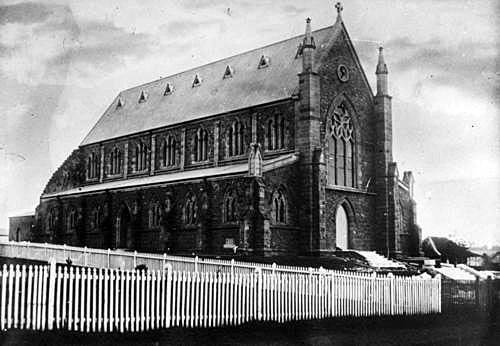
St Patrick's Church, Toowoomba, c.1894
[Photograph: John Oxley Library, State Library of Queensland]
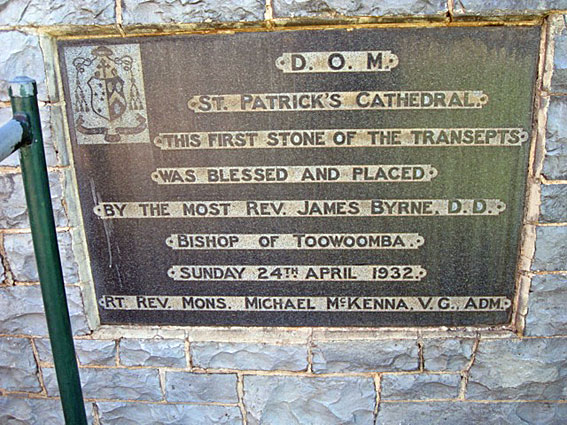
Foundation stone for additions to the Cathedral in 1932
[Photograph by Geoffrey Cox (June 2012)]
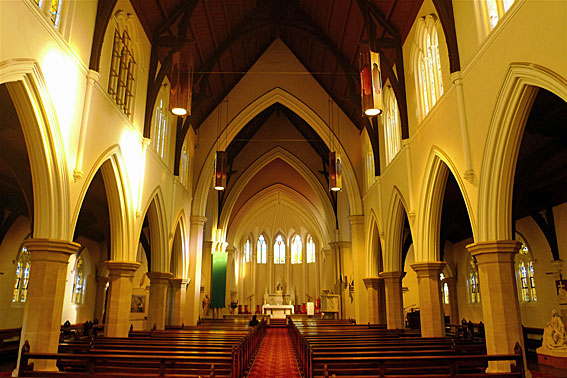
General interior view of St Patrick's Cathedral, Toowoomba
[Photograph by Trevor Bunning (November 2011)]
Present Organ.
The organ was built by Whitehouse Bros of Brisbane in conjunction with the enlargement and completion of the Cathedral, and a plaque on the instrument records that it was presented to the Cathedral by Mrs Patrick Gaven in 1935. The firm's ledger entry is dated November 1934. It records that the specification had been drawn up in July 1933, and that a quotation for the oak casework had been given in May 1934. The total cost was £1,683, and the final payment was made in January 1935.3

Plaque acknowledging the gift of the organ in 1935
[Photograph by Geoffrey Cox (June 2012)]
This was the largest of the firm's electro-pneumatic extension organs, comprising seven ranks of pipes, most of which are extended over two manuals and pedals. The first instrument of this type had been built by the firm for St Andrew's Presbyterian Church, Bundaberg in 1932, followed by others at Holy Rosary Catholic Church, Bundaberg (1933), the Presbyterian Church, Ithaca (1933) and St James' Catholic Church, Forest Lodge, NSW (1934).
.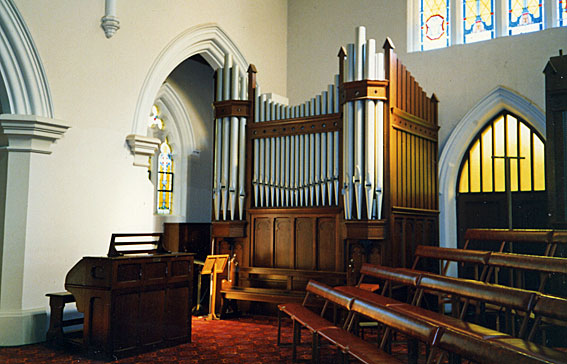
The 1935 Whitehouse Bros organ
[Photograph by Howard Baker (1990s)]
The detached roll-top console, imported from Aug. Laukhuff, is a standard Whitehouse type of the period that can be observed, for example, at the Methodist Church, Chatswood (1930), Holy Rosary Catholic Church, Bundaberg (1932), the New England Girls' School, Armidale, NSW (1936).
The divided oak case has façade pipes only in the left-hand section. Comprising two towers with decorative braces and a central flat with transom rail, the design was standard to many Whitehouse organs of the late 1920s and early 1930s, including those at St Andrew's Presbyterian Church, Inverell (1927), St Paul's Presbyterian, Armidale (1929), St Andrew's Presbyterian, Chatswood (1930), and the Presbyterian Church, Ithaca (1933).
The organ was originally located in the rear gallery (choir loft) on either side of the window, with the console placed in the centre. It was restored and removed to the transept by Walter Emerson of Toowoomba in 1973-74, when the rear gallery was removed.4 This was in association with extensive renovations to the Cathedral that had commenced in 1972.5
Extensive restoration of the organ was undertaken in 2020 by Pierce Pipe Organs of Brisbane. This involved the following work:
• All soundboards and chests were fully flooded, sealed and refurbished,
• The internal motors were recovered in polypel with new valves,
• The Reisner magnets were rewired and fitted with new armatures,
• The bellows were releathered,
• The wind trunks were rebedded,
• The 1935 mechanical switchgear was replaced with a new solid state relay from Richard Larritt, (Removal of the mechanical relay has created space inside the case for more ranks to be added at a later date).
• The console has been repolished and fitted with new P&S keyboards, new stop-tab switches and new wiring throughout.6

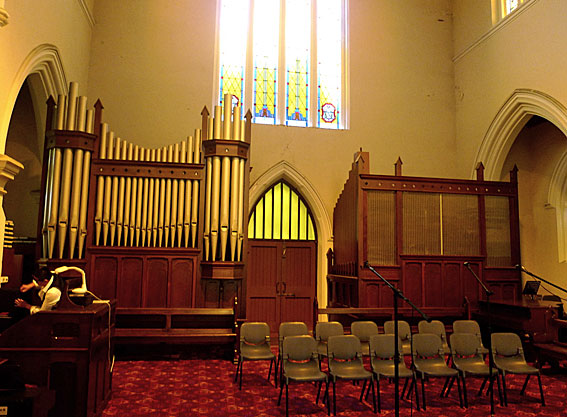

The 1935 Whitehouse Bros organ
now located in the south transept
[Photographs by Trevor Bunning (November 2011)]
| GREAT Double Open Diapason Stop Diapason Gamba Principal Flute Dulcet Trumpet SWELL Bourdon Principal Gedact Viol Octave Flute Salicet Piccolo Cornopean Oboe PEDAL Sub Bass Bourdon Bass Flute Octave Cello COUPLERS Great to Pedal Swell to Pedal Swell to Great Great Sub Great Super Swell Sub Swell Super |
16 8 8 8 4 4 4 8 16 8 8 8 4 4 4 2 8 8 16 16 8 8 8 |
A B A C B A C D A E A C E A C [later renamed 'Viol'] A D F G A G A C |
Detached stop-key console
Electro-pneumatic action
Oboe tremulant
General tremulant
Compass: 61/30
3 thumb pistons to Swell Organ
3 thumb pistons to Great & Pedal Organs
3 toe pistons to Great & Pedal Organs.7

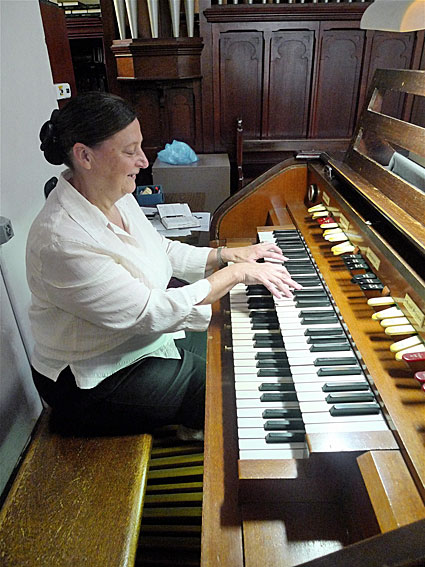



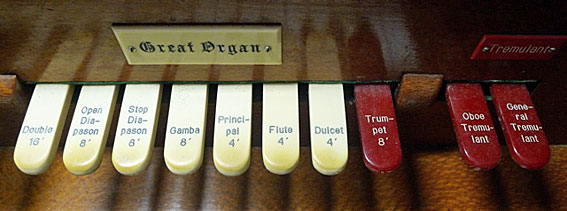
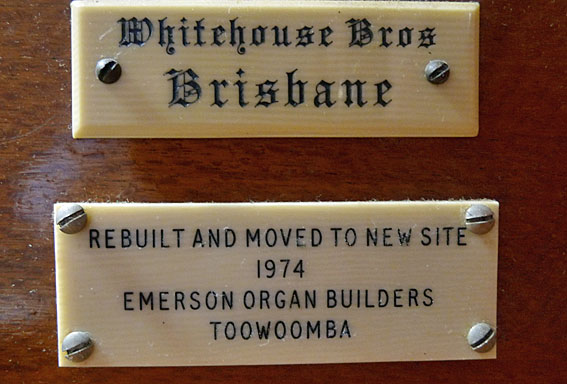
Console details of the 1935 Whitehouse Bros organ
[Photograph by Trevor Bunning (November 2011)]
Organ in Storage.
A second organ has been in storage at this location since around 1998, with a view to rebuilding and enlarging the present instrument.8 It was built originally by B.B. Whitehouse & Co of Brisbane in 1913 for the Park Presbyterian Church, South Brisbane, (now Highgate Hill) and comprises 2 manuals with 12 speaking stops and tubular-pneumatic action.
_____________________________________________________________________
1 Queensland Heritage Council, Queensland Heritage Register, location 600844; Donald Watson & Judith McKay, Queensland Architects of the 19th Century: A Biographical Dictionary (Brisbane: Queensland Museum, 1994), pp. 121-22.
2 The Courier-Mail (25 March 1935), p. 12.
3 Whitehouse Bros Ledger (1922-1940), p. 483.
4 Personal communication to G. Cox from Walter Emerson, February 1974.
5 Queensland Heritage Council, Queensland Heritage Register, location 600844.
6 "News from Organbuilders," OHTA News, vol. 45, no. 3 (September 2020), p. 4.
7 Specification noted by G. Cox, February 1974.
8 Personal communications to G. Cox from Simon Pierce, January 2001 and March 2003.